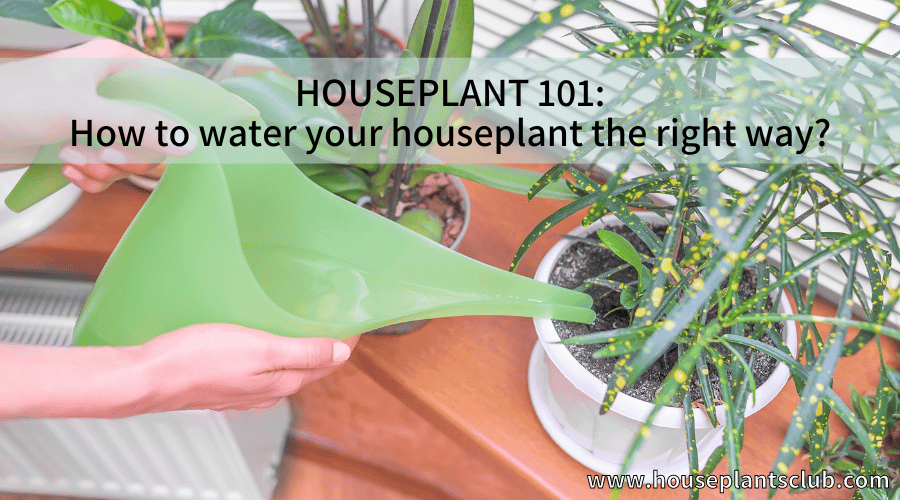I overheard two women arguing about which part of the plant to water at a nursery near my house a few days ago. Each had a different opinion and believed she knew the correct answer, but I had to find out which part of the plant needed to be watered. I knew it was necessary to water from the soil, but the woman who claimed the opposite challenged me. Here are my conclusions.
The part of the plant that should be watered is the soil. This is not just the soil close to the plant but also the entire soil in the pot since our house plants’ roots often spread throughout the entire soil, not just close to the trunk. Consequently, do not just water around the plant’s base; moisten all the soil around it and cover the entire root zone with water.
This article contains 8 excellent tips for adequately watering house plants to ensure that your indoor plants thrive and grow well, so make sure you use these tips when watering your indoor plants.
8 tips for watering indoor plants properly
Make sure the pot has drainage holes.
Your houseplants should have a pot with drainage holes. They are responsible for removing excess water from the soil, so if we don’t use a pot with drainage holes, we may overwater our houseplants because the excessive water will not come out of the pot. This may cause our houseplants to rot in the long run.
Make sure the soil is thoroughly soaked.
Keeping with the previous tip, don’t give your indoor plants a sip of water. Ensure the soil is soaked thoroughly until water drains from the pot’s drainage holes. This promotes the health of the roots.
Make sure you use a watering can.
You can precisely direct water flow to the base of a houseplant using the long spout of a watering can. In addition, watering with a watering can is also better than water with a glass or a pitcher with a wide spout, which could splash everywhere except your plant’s soil.
Don’t follow any watering schedule.
When watering indoor plants, I don’t know how people came up with the definitions of exactly once a week, exactly once a month, on nights of a full moon, etc. But they are all wrong. Suppose I live in New York and someone tells me when to water my plants from London or Bangkok, but the humidity in each city is entirely different. The sunlight each city receives directly affects the answer to the question “when to water my plant.” Water each plant at its own pace, depending on how moist the soil is, as well as the needs of the plant. It is also important to note that the seasons differ from one another. Therefore, the correct way to water your plants is to only look at the soil’s moisture condition. The same plants will receive different amounts of water in winter and summer.
Misting does not replace watering.
In my article about houseplant mist, I mention how important it is for our plants. Although misting the leaves of our houseplants benefits the plants, it does not replace watering the soil. The amount of water reaching the plants through mist maintains a moist environment and our plant’s soil receives the water we need to grow and thrive.
As needed, water your indoor plants.
Feel the soil to determine when your houseplants need water.
Each plant needs water at a different time. Some plants require their soil to dry out completely, while others require their soil to remain moist constantly, so pay attention to each plant in your houseplant collection to ensure they thrive. If one plant requires periodic watering, it does not mean all the plants should do the same.
Avoid potting mixes that are too water-retentive.
Choosing houseplant potting soil that is well-draining and doesn’t stay soggy for hours after watering is essential for houseplants.
The best potting soil for houseplants should contain coconut coir, perlite or vermiculite, which aerate the soil and promote drainage. Make sure there is no more than one part of peat moss in the mix if you want the best results.
Water your plants Slowly.
When the soil surface is dry, water will puddle and run off, which can cause the soil to become unproductive. To avoid this, start slowly and increase the amount of water gradually. Once the top few inches are moist enough, water will soak into the soil more readily.

Frequently asked questions
Watering plants properly is essential since we risk not providing enough water if we don’t wet all the soil in our plant vessel.
The best water to use when watering your plants is rainwater. However, filtered water can also water plants because it is not always available. If you cannot access these two types of water, tap water should be left in the container for 24 hours, then water the plants.
Plants may not grow as tall and robust as they should if you use tap water. To reduce the risk of harmful chemicals in your water, let it sit out for at least 24 hours before watering your plants. This allows for the chlorine to dissipate. For exchanges, you can use filtered water or rainwater.

Recent Posts
Unlocking the secret to expanding your begonia maculata family is like discovering a treasure trove of green goodness. If you've ever marveled at the stunning beauty of angel wing begonia leaves and...
If you've ever found yourself marveling at the surreal beauty of air plant blooms, you're in for a treat! These enchanting bursts of color amidst a sea of lush green foliage are like nature's way of...




